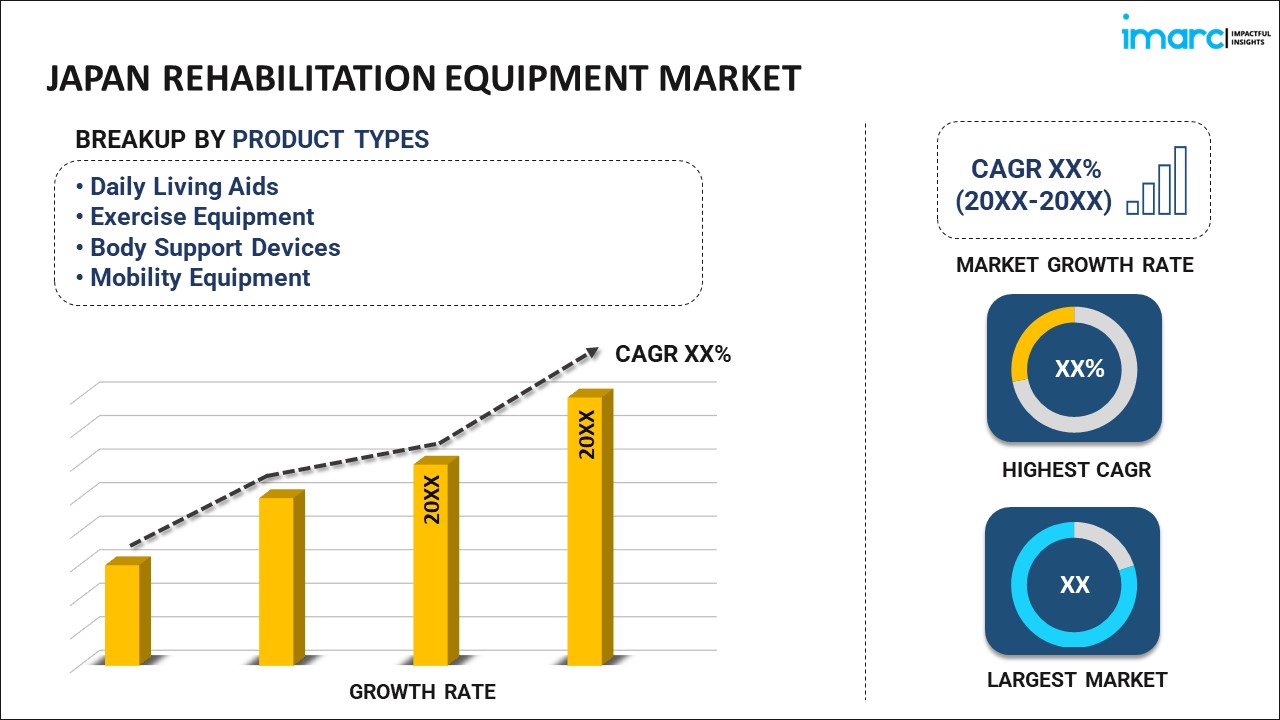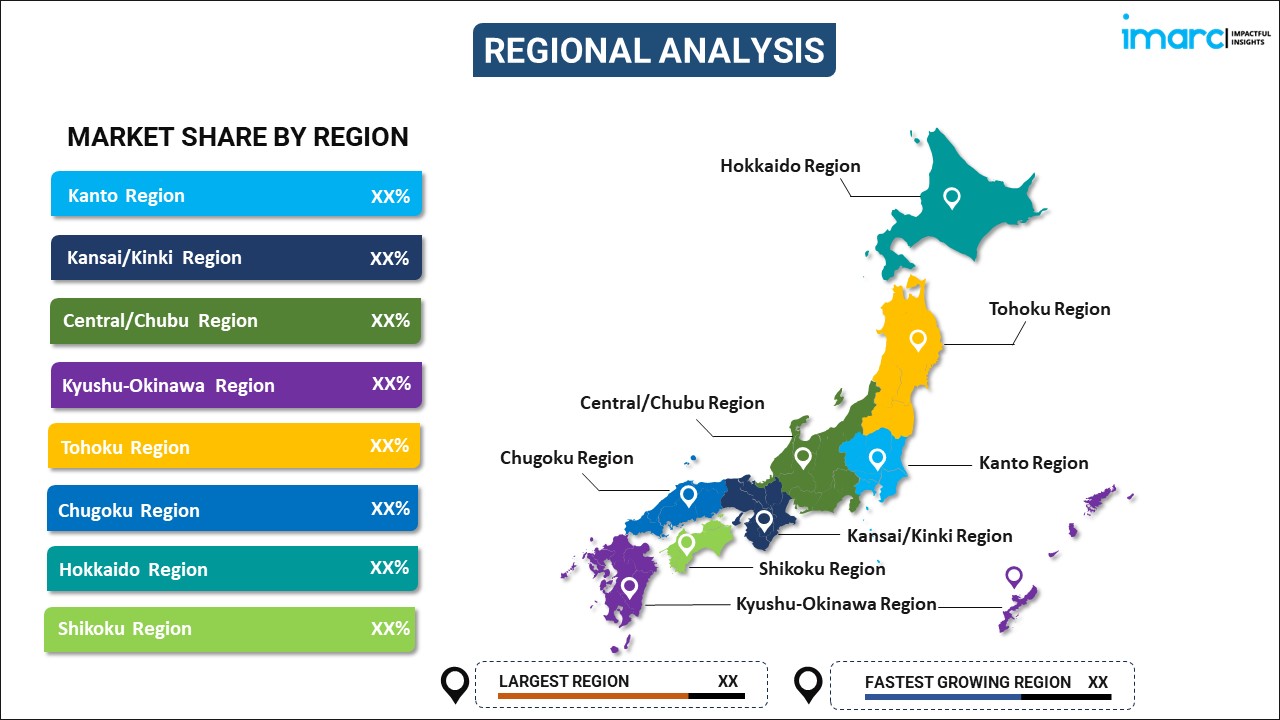
Japan Rehabilitation Equipment Market Report by Product Type (Daily Living Aids, Exercise Equipment, Body Support Devices, Mobility Equipment), Application (Physiotherapy, Occupational Therapy), End Use (Hospital and Clinics, Rehab Centers, Home Care Settings, Physiotherapy Centers), and Region 2025-2033
Market Overview:
Japan rehabilitation equipment market size reached USD 679.5 Million in 2024. Looking forward, IMARC Group expects the market to reach USD 1,261.2 Million by 2033, exhibiting a growth rate (CAGR) of 6.58% during 2025-2033. The rising need for enhanced equipment and clinical outcomes, along with the increasing adoption of remote healthcare programs, is primarily driving the market growth.
|
Report Attribute
|
Key Statistics
|
|---|---|
|
Base Year
|
2024 |
|
Forecast Years
|
2025-2033
|
|
Historical Years
|
2019-2024
|
| Market Size in 2024 | USD 679.5 Million |
| Market Forecast in 2033 | USD 1,261.2 Million |
| Market Growth Rate (2025-2033) | 6.58% |
Rehabilitation involves a range of interventions aimed at maximizing or reinstating human capabilities through a combination of training, therapies, and medicinal approaches. Rehabilitation equipment commonly include devices for mobility, walking assistance, body support, therapy, and continuous passive motion (CPM). These tools are utilized to prevent secondary disabilities, enhance flexibility, strengthen muscles, and improve overall physical attributes such as strength, coordination, and endurance. In addition to this, by doing so, they contribute to reducing the risk of both mental and physical complications. Consequently, rehabilitation equipment find widespread application in physiotherapy and occupational therapy procedures.
Japan Rehabilitation Equipment Market Trends:
The Japan rehabilitation equipment market is experiencing substantial growth driven by several influential factors. Notably, the increasing prevalence of various chronic and non-communicable diseases like cancer, arthritis, and Parkinson's, particularly among the aging population, has led to extensive utilization of rehabilitation equipment across various healthcare settings including clinics, hospitals, home care, and rehabilitation centers, which is positively influencing the regional market. Furthermore, the outbreak of the COVID-19 pandemic prompted the adoption of virtual and remote healthcare programs on online platforms, thereby acting as another significant growth-inducing factor. This shift has further enabled patients to access personalized training and medication, as well as share diagnostic records with rehabilitation professionals, further bolstering market growth. Moreover, to meet the surging demand for enhanced equipment and clinical outcomes, key market players are actively collaborating with other companies to introduce cost-effective, durable, and high-performance rehabilitation equipment, thus contributing to market expansion in Japan. Additionally, increased investments in research and development (R&D) activities, rising consumer healthcare expenditure, and various supportive initiatives by government and non-government organizations aimed at strengthening healthcare infrastructure are also collectively creating a positive outlook for the rehabilitation equipment market in Japan. These factors combined suggest a promising future for the market in the country.
Japan Rehabilitation Equipment Market Segmentation:
IMARC Group provides an analysis of the key trends in each segment of the market, along with forecasts at the country level for 2025-2033. Our report has categorized the market based on product type, application, and end use.
Product Type Insights:

- Daily Living Aids
- Medical Beds
- Bathroom and Toilet Assist Devices
- Reading Writing and Computer Aids
- Others
- Exercise Equipment
- Upper Body Exercise Equipment
- Lower Body Exercise Equipment
- Body Support Devices
- Patient Lifts
- Medical Lifting Slings
- Mobility Equipment
- Walking Assist Devices
- Wheelchairs and Scooters
The report has provided a detailed breakup and analysis of the market based on the product type. This includes daily living aids (medical beds, bathroom and toilet assist devices, reading writing and computer aids, and others), exercise equipment (upper body exercise equipment and lower body exercise equipment), body support devices (patient lifts and medical lifting slings), and mobility equipment (walking assist devices and wheelchairs and scooters).
Application Insights:
- Physiotherapy
- Occupational Therapy
A detailed breakup and analysis of the market based on the application have also been provided in the report. This includes physiotherapy and occupational therapy.
End Use Insights:
- Hospital and Clinics
- Rehab Centers
- Home Care Settings
- Physiotherapy Centers
The report has provided a detailed breakup and analysis of the market based on the end use. This includes hospital and clinics, rehab centers, home care settings, and physiotherapy centers.
Regional Insights:

- Kanto Region
- Kansai/Kinki Region
- Central/ Chubu Region
- Kyushu-Okinawa Region
- Tohoku Region
- Chugoku Region
- Hokkaido Region
- Shikoku Region
The report has also provided a comprehensive analysis of all the major regional markets, which include Kanto Region, Kansai/Kinki Region, Central/ Chubu Region, Kyushu-Okinawa Region, Tohoku Region, Chugoku Region, Hokkaido Region, and Shikoku Region.
Competitive Landscape:
The market research report has also provided a comprehensive analysis of the competitive landscape. Competitive analysis such as market structure, key player positioning, top winning strategies, competitive dashboard, and company evaluation quadrant has been covered in the report. Also, detailed profiles of all major companies have been provided.
Japan Rehabilitation Equipment Market Report Coverage:
| Report Features | Details |
|---|---|
| Base Year of the Analysis | 2024 |
| Historical Period | 2019-2024 |
| Forecast Period | 2025-2033 |
| Units | Million USD |
| Scope of the Report | Exploration of Historical Trends and Market Outlook, Industry Catalysts and Challenges, Segment-Wise Historical and Future Market Assessment:
|
| Product Types Covered |
|
| Applications Covered | Physiotherapy, Occupational Therapy |
| End Uses Covered | Hospital and Clinics, Rehab Centers, Home Care Settings, Physiotherapy Centers |
| Regions Covered | Kanto Region, Kansai/Kinki Region, Central/ Chubu Region, Kyushu-Okinawa Region, Tohoku Region, Chugoku Region, Hokkaido Region, Shikoku Region |
| Customization Scope | 10% Free Customization |
| Post-Sale Analyst Support | 10-12 Weeks |
| Delivery Format | PDF and Excel through Email (We can also provide the editable version of the report in PPT/Word format on special request) |
Key Questions Answered in This Report:
- How has the Japan rehabilitation equipment market performed so far and how will it perform in the coming years?
- What has been the impact of COVID-19 on the Japan rehabilitation equipment market?
- What is the breakup of the Japan rehabilitation equipment market on the basis of product type?
- What is the breakup of the Japan rehabilitation equipment market on the basis of application?
- What is the breakup of the Japan rehabilitation equipment market on the basis of end use?
- What are the various stages in the value chain of the Japan rehabilitation equipment market?
- What are the key driving factors and challenges in the Japan rehabilitation equipment?
- What is the structure of the Japan rehabilitation equipment market and who are the key players?
- What is the degree of competition in the Japan rehabilitation equipment market?
Key Benefits for Stakeholders:
- IMARC’s industry report offers a comprehensive quantitative analysis of various market segments, historical and current market trends, market forecasts, and dynamics of the Japan rehabilitation equipment market from 2019-2033.
- The research report provides the latest information on the market drivers, challenges, and opportunities in the Japan rehabilitation equipment market.
- Porter's five forces analysis assist stakeholders in assessing the impact of new entrants, competitive rivalry, supplier power, buyer power, and the threat of substitution. It helps stakeholders to analyze the level of competition within the Japan rehabilitation equipment industry and its attractiveness.
- Competitive landscape allows stakeholders to understand their competitive environment and provides an insight into the current positions of key players in the market.
Need more help?
- Speak to our experienced analysts for insights on the current market scenarios.
- Include additional segments and countries to customize the report as per your requirement.
- Gain an unparalleled competitive advantage in your domain by understanding how to utilize the report and positively impacting your operations and revenue.
- For further assistance, please connect with our analysts.
 Inquire Before Buying
Inquire Before Buying
 Speak to an Analyst
Speak to an Analyst
 Request Brochure
Request Brochure
 Request Customization
Request Customization




.webp)




.webp)












